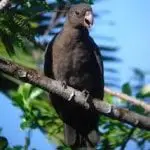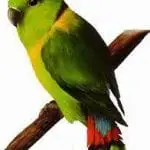Scientific Facts
| Common Name | Black-cheeked lovebird |
| Scientific Name | Agapornis nigrigenis |
| Size | 5.5 inch (14 cm) |
| Life Span | 19 years |
| Habitat | Farmland, Woodlands |
| Country of Origin | South-western Zambi |
Over-accumulated for the pet industry still not acknowledged by most pet keepers or bird ranchers, the Black-cheeked Lovebird is one of the forgotten species of the eye-ring lovebird flock, since it was cross-bred, presumably both consciously and unconsciously, with the bigger, more attractive Masked Lovebird.
The Black-cheeked occasionally is mystified with the Masked Lovebird ( Agapornis Personatis). The Black Cheeked Lovebird in the 1930s, regardless of huge quantities being shipped within Europe, is kept in very moderate figures in Australia because of the confined numbers being conveyed before the 1949 Australian Government import prohibition.
Physical Description
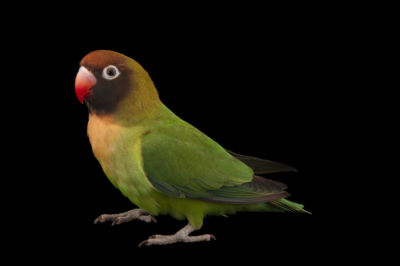
The Black-cheeked Lovebird is slightly smaller than the Fischers, or Masked members of the “Eye ring” or The Black-cheeked Lovebird is somewhat tinier than the Masked or Fischer’s brothers of the “Eye ring” or “personata” group. (Eye-rings are described for the white apteric rings encompassing the eyes). The grown-up standards 5 – 5.5 inches (13 – 14 cm ) in height (including its pointed tailpiece) and balances between 1.4 – 1.6 oz (40 and 45 grams).
It possesses essentially green feathers, brownish-black cheeks, and throat, the orange patch below the throat, which fades to yellowish-green, reddish-brown forehead and forecrown, grey feet, and blackface.
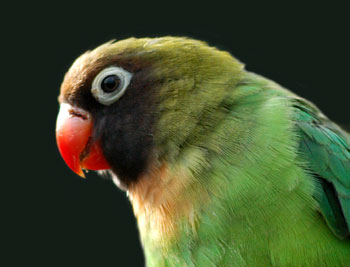
Grown-ups have brilliant red noses, at the same time, youngsters of the species are comparable though with a further orange beak. Youngsters are dark in the shade until following the initial exfoliate. Juvenile birds have black brandings at the bottom of the beak.
Mutations: Black-cheeked has no validated (exact) modifications. The mutations that are frequently obtainable in the shop are crossbreeds of Masked and Black-cheeked Lovebirds. This being stated, a dazzling azure variation has been listed – although its chastity is still to be approved.
Geographical Range
Approximately 10 000 exist in the mopane Colophospermum mopane forest in south-west Zambia. With perpetual standing water, they are concentrated with an enormous vulnerability on the mopane forest. Some birds may likewise transpire in the western tip of Zimbabwe, in the eastern part of Namibia’s Caprivi Strip, and the northern tip of Botswana. Nonetheless, its rank here is obscured by the existence of primitive lovebirds of higher than one species.
The central population is a disconnected area of the mopane forest between the Kafue and Zambezi rivers. The population outside the barren period is more extensive and linked to the accessibility of growing products adjacent to scraps of mopane forest or riverine woodland. The whole range of mopane forest employed is about 4 550 km2.
Habitat
The territory is erratic, exhibiting continuous dehydration in the range. There are several perennial water reservoirs accessible now than earlier this centenary, and the population has been influenced by the continuous withering of some transient currents. Low accessibility of water in the dry season has presumably been the major determinant provoking lovebirds to abandon the Sinde and Bovu rivers.
Lovebirds are recognized by social individuals as they settle on products, prominently millets, and sorghum. The overall transformation of these products to maize in the second part of this centenary may have produced an earlier impression on lovebird abundances and population.
Common Behavior
Because the Black-cheeked Lovebird was awkwardly grouped in among the Masked Lovebird by so several amateurs for incredibly lengthy, it’s innoxious to believe that their character will be greatly similar to that of their higher sibling. Be ready for boundary problems. A couple should have their area, with no additional lovebirds or animals held in the enclosure or also permitted to reach the coop. Even the most passionate particular pet is feasible to get a complaint to someone placing their palms adjacent or within the enclosure. Consequently, twig-exercise the lovebird so that it can drive inside and outside of the enclosure in form is necessary.
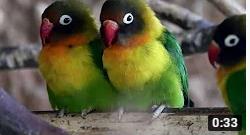
Assume that barely the most pleasant infant hand-served Black-cheeked Lovebird will drop its gentleness if you don’t engage with the pet each particular day. A forgotten lovebird can amplify the common management dilemmas of every lovebird, including plumage plucking, crying, and snapping.
Diet
The Black-cheeked Lovebird serves largely at terrain-level on yearly lawn grains, but additionally on other herb constituents and bug worms, and maize, millet, and sorghum.
Confined lovebirds must be supplied with a class lovebird grain blend, in enhancement to giving them fruits (berried, apples, etc.) and vegetables. It is suggested to increase their nutrition with minerals and vitamins. Bird-particular vitamins are prepared at the veterinarian or more reliable pet shops. Cuttlebone and mineral chunks must be administered the entire year.
Clean absorbing and soaking water must likewise constantly be accessible to them.
Reproduction and Life Cycle
Black-cheeked lovebirds reproduce in pockets in developed mopane woods near lodging sections from January to May. Reproducing couples presumably work the corresponding cradle area many times over.
How to Breed
Black-cheeked Lovebirds are comparatively comfortable to reproduce, though possessing solely been lately ascertained in aviculture, they are not as strong as other, more organized, lovebird species. This is possibly generated by comprehensive incest of present merchandise because of their low figures. This may consider for decreased productivity, poor survival of young, increased susceptibility of disease, and low hatchability of fertile eggs.
They commonly commence to reproduce at the span of 10 to 12 months and may proceed till they are five to six years.
Black-cheeked Lovebirds are passive and tranquil and will reproduce in a community perspective; though, overpopulation can induce anxiety. It is likewise essential to have in thought that throughout the breeding season, the male exhibits more offensive action.
Well-matched Black-cheeked Lovebirds can be productive growers – conceivably offering three clutches in a period. Though, they must be permitted to sleep in between clasps to limit clear eggs, delicate, dead-in-shell, and debilitated parents – and to refrain well-being dilemmas in the female in particular.
The breeding season generally begins in March or April. Before the reproducing period starts, the dwelling receptacles must be examined and thoroughly cleansed. There are dwelling receptacles for lovebird-size birds, though if not possible, a cockatiel dwelling receptacles will do exactly subtle. The traditional dwelling supply must be substituted with a fresh underlayer (moss, peat, hay, etc.). The bird is possible to supplement fine branches, shell, and plumage to stuff the dwelling receptacles with. The male may support the concrete cradle construction.
Once the cradle crates are adjusted to their desire, courting and coupling transpire. The male’s response generally includes numerous head-scrubbing accompanied by head bouncing at the same time spinning around on the birdhouse in the presence of his female. The bird squats down on the roost with both plumes spread, encouraging the male to match with her. The couple is observed ejecting food and nurturing one another
Before egg yielding, the female’s excrements are bigger and moister in extent. She consumes more experience at the mollusk, obtaining the calcium she requires for egg generation. Once egg setting begins, the bird yields on makeshift courses. The standard clasp measurement consists of 3 to 6 eggs, and the bird nurtures the eggs for roughly 21 – 23 days. The female barely deserts the cradle for dining or to soothe herself. The male accesses the crate to fill the female.
The recently born youngsters are embraced with a pinkish underneath. Their eyes are shut and stay closed for nearly 10 days. During this moment, in special, the progenitors are very defensive of their lair and become quickly agitated by cradle maneuvers, which must be held at a minimal. With a newborn in the cradle, raising meat must be given. At the cloudy stage, fresh sweet corn is readily received.
The juvenile will be attended by the female until they abandon the cradle at approximately six weeks of age. The father later carries over the fulfilling of the juvenile birds for added two weeks, or therefore until they are removed.
It is most suitable to accommodate removed chicks their dwelling crates. One method to distinguish harmonious partners is to enable them to link and match up normally. One can discover genuine and agreeable couples rest mutually in a cradle crate before they are mature enough to reproduce.
After the breeding season, the cradle crates must be washed, the platform treated with a proper underlayer, and settled back toward the birdhouse for the lovebirds to utilize for perching and having heated throughout the winter season.
Close-whistling must be arranged when the youngsters are 12 to 14 days old. The youngsters will abandon the cradle crates when they are roughly 42 days old – consequently, they will be thoroughly plumate and ready to circumnavigate.
Once the female is producing embryos again, it is most beneficial to eliminate the unaccustomed juvenile.
The roosts in the flight must be native twigs of various extents, which is vital for sturdy feet.
Pet Care
Housing:
A single Black-cheeked Lovebird that you desire to stay trained must have a powder-smeared alloy enclosure, possibly 60 cms width by 45 cms diameter by 60 cms height with 1.2 cms pole placing, but it shouldn’t be too uncomfortable or too large for you to install a branch in the enclosure so the bird can “assemble” on appeal and drift out into the public. You don’t desire the lovebird to grow enclosure-confined, since you want to bring your pet outdoors every particular day and engage with it in an agreeable space such as a playpen or also on your person, for at least an hour.
If it’s a nuisance to transfer your pet from the enclosure, and you allow it travel, your bird will presumably suffer its gentleness somewhat swiftly. A tinier enclosure and more experience together are more salutary than a larger enclosure with less chance if you need to maintain the generosity of your lovebird.
If you are concerned about excessive broody behavior and egg-binding in a female Black-cheeked Lovebird, you may have to reserve a perch receptacle and passage to dwelling substances, including branches. Seek more difficult and scavenging stuff and fewer concealing areas or wood twigs.
If you possess a couple of Black-cheeked Lovebirds, who are linked to one another, then you must make or create the most extensive flock you can control. They want to train, to perform, and to circumnavigate, but they will favor to take it with each other, in their region, so be extremely benevolent. If you cannot obtain an extensive flight with adequately little pole placing, you may possess to produce something personalized, but it will be beneficial.
Diet:
Black-cheeked Lovebirds may not take the healthy nutrition cherished by numerous other pet lovebirds. During which a few specialists suggest that you prefer a grained menu, the truth may imply that your lovebirds at no time receive it, unless they were bred to consume grains or crushes from the very start. More practical nutrition, for several humans, will be a high-caliber little grain mix, simultaneously with a wonderful diced mixture carrying loads of nutrient-rich vegetables and fruits.
Here’s a touch: Merge or germinate the grains to produce a fresh, hearty salad with more dietary substance than merely the traditional grain. You can likewise give a diverse cooked rice dish, seeds, and legume. Never administer avocado or chocolate the Black-cheeked Lovebird, as these foods are lethal to all lovebirds.
Examine with your laborer, pet shop, or doctor regarding vitamin additions, particularly if your Black-cheeked Lovebird is a choosy consumer. There are records of females’ weakening of egg-restraining, an ailment frequently associated with a vitamin A scarcity. Shredded carrot or cooked sweet potato or yam can be an essential element in your lovebird’s food dish. Calcium insufficiency can be an added reason. To adopt nutritive calcium, lovebirds require to be introduced to direct daylight or comprehensive brightness, or some makeshift origin of vitamin D3.
Temperature
Make certain the standard studio condition is approximately 27° C. Because they favor a mild environment, have them inside throughout winters as lengthened vulnerability to moist and freezing climate is inappropriate for these birds.
Temperament
These adorable lovebirds, frequently living in couples, can be notably colonial, especially throughout their reproducing period when managed with other birds in a huge enclosure or birdhouse.
It is recommended to engage with them regularly to maintain their gentleness. I handfed and disciplined; these lovebirds can execute skills as well. They are timid; therefore, overpopulation can be traumatic for them.
Notwithstanding their gratifying nature, their high-frequency screeching sound can seem like an annoyance.
Consideration
Soak your Black-cheeked lovebird two events in a week utilizing a spray shower. Guarantee overall sanitation by washing its enclosure and confederates daily as well as maintaining freshwater in its cage every day.
Considering it gets extremely bold if permitted to spread out of its enclosure, make certain to have all dangerous objects away of its range.
Availability
Rare in aviculture, as it is not simple to spot these birds in markets. Though, it is considerably prevalent among poultry growers nearby, and regularly present in ornithological displays.
The Black-cheeked Lovebird They are less boisterous compared to other species of Lovebird. They fancy showering. They are snapping, tough, energetic, and friendly. They readjust completely to living in the group, accompany with birds of the identical species and Lilian’s Lovebird (Agapornis lilianae). If an area is confined distribution, they can attack one another, although it is frequently more tranquil than other species Agapornis. They do not desire the pitch, so it is than other Agapornis presence in intimate association with a human.
Threats
There is proof that sale in native species is presently at a surprisingly low rank, with separate occurrences and shipping business, although it is obvious that any foreign business is met with interest. Several lovebirds are apprehended for expenditure and further sought as annoyances. Gardeners take actions to lessen the destruction of products; however, they are mainly worthless.
The prevailing rank of research: it is not expected to possess a dangerous long-term impression on the community, but it might threaten economic communities experiencing from the impacts of dehydration.
Conservation
The Black-cheeked Lovebird has a conservation status of Vulnerable. They are still seized for both the pet business and for nourishment, while the accumulation of native Black-collared Lovebirds is prohibited. In the initial half of the 20th century from capitalization, the species experienced its vastest slumps, as well as territory damage and variations in cultivation systems. The birds further require constant passage to freshwater, which may be obstructed by individual pursuits. Training plans and environment conservation are initiated to maintain this species to remain in the native.
Facts
Black-cheeked lovebirds nurture each other throughout the breeding season.
They are so connected to their partners that one of them might shift into despair when the other perishes or moves away.
FAQs
How long do black masked lovebirds live?
Your lovebird’s existence can last between 10 to 20 years in confinement with decent attention. With a nutritive menu, they are powerful birds but can possess breath difficulties, feather disease, and liver disease.
Are lovebirds endangered?
The black-cheeked lovebird is the most endangered in the native of the entire species of lovebirds. It is classified as Vulnerable, which is merely one level away from Endangered.
Do lovebirds mate for life?
Lovebirds are little parrots, of the taxonomic genus Agapornis. Nine lovebird species exist, though barely three are generally held as pets. All of the certain species create powerful, monogamous couple links and frequently match for life.
How often does a lovebird poop?
Excrement cycle: once every 30-40 mins.
How much attention does a lovebird need?
They are adequate for amateurs but demand a little more effort than other species. They are properly maintained as couples since they need so much consideration and love
Can you train a lovebird?
If your pet lovebird already identifies you and is composed of your demeanor, you can begin the exercise.
Why won’t my bird stop screaming?
Lack of exercise, injury, illness, boredom, or solely as an articulation of pleasure are all ideas for communications in lovebirds.


